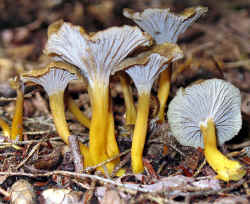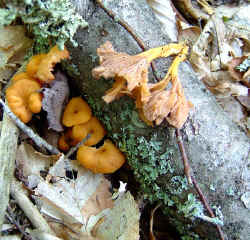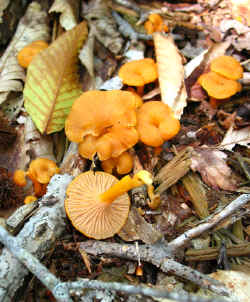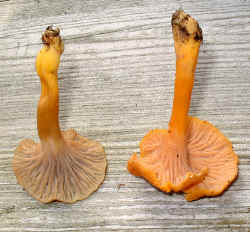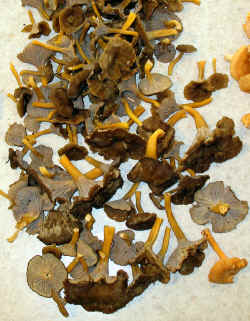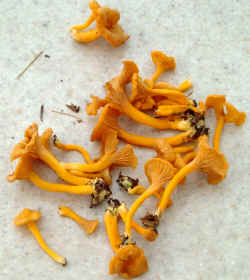|
|
A New England and Eastern Canada Edible and Medicinal Mushroom Resource |
|||
Home
Chanterelle (Cantharellus cibarius) Black Trumpet (Craterellus cornucopioides, C. cenerius, C. foetidus) Small Chanterelles (Craterellus tubaeformis, C. ignicolor) Hedgehog (Hydnum repandum, H. umbilicatum) Horse and Meadow Mushroom (Agaricus arvensis, A campestris) Parasol Mushroom (Macrolepiota procera) Shaggy Mane (Coprinus comatus) (White) Matsutake (Tricholoma magnivelare) Blewit (Lepista nuda) Oyster Mushroom (Pleurotus ostreatus, P. populinus)
King Bolete (Boletus edulis) Boletus variipes and other. Two Colored Bolete (Boletus bicolor) Maitake (Grifola frondosa) Chicken of the Woods (Laetiporus sulphureus) Dryads Saddle (Polyporus squamosus)
Morels (Morchella esculenta, M. elata) Puffballs (Calvatia gigantea, Calvatia cyathiformis, others) Lobster Mushroom (Hypomyces lactifluorum) Aborted Entoloma (Entoloma abortivum)
Medicinal Mushrooms Maitake (Grifola frondosa) Reishi (Ganoderma tsugae, G. lucidum) Turkey Tail (Trametes versicolor) Chaga (Inonotus obliquus) Artist's Conk (Ganoderma applanatum)
Collecting, Photographing and
Cooking Collecting
Tips Evaluating
Flavor Dyeing Fabrics and Paper with Mushrooms
|
The "Small
Chanterelles"
There are smaller, more delicate "chanterelles" that grow throughout the summer and into the fall. They have a similar look to chanterelles with their shape and the blunt edge gill like ridges that run partway down the stem. They seem to be half way between a chanterelle and a black trumpet with their semi hollow funnel-like shape. These were previously classified in the Cantharellus group but DNA study has placed them in the Craterellus group (clade). These are really tough to figure out for taxonomists but the various small "chanterelles" seem to all be edible. I personally ingested the pictured specimens. I suspect that these are saprobic rather than mycorrhizal as they are often found on or near very dead wood. An experiment I am conducting may shed some light on this. Cap (pileus) 3/4 - 2 1/2 in wide for both species. Funnel shaped and somewhat delicate compared to Cantharellus cibarius the "golden chanterelle". Craterellus tubaeformis has a yellowish brown or brown funnel shaped cap. Craterellus ignicolor looks very similar but is yellow orange. Ridges Blunt, forked and often wavy gill-like ridges that run partway down the stem and are quite shallow often looking like veins. C. tubaeformis has gray or violet gray blunt ridges descending the stem. C. ignicolor has yellow orange ridges that descend the stem Stem (stipe) Yellow-orange in either species developing hollowness with age. C. tubaeformis often has slightly browner tones. Flesh C. tubaeformis flesh is brownish yellow. C. Ignicolor is orange-yellow. Spores Whitish spore print for both species When and where to find them (ecology) From August to November these can be found around similar locations of hardwoods and mixed woods especially where dead wood, wood chips, or thick duff is present. Sphagnum type mosses are often present. They are more likely to be in clusters than chanterelles (Cantharellus cibarius). They are quite common and can be an indicator that black trumpets are nearby. The smell is a good indicator. If you place them in a closed bag for a few minutes and then open it and smell there will be a beautiful perfume-like, fruity aroma that some say is like apricots. It smells only remotely like apricots to me but it is distinctive and really pleasant. Preparation Try only a little the first time. These have a really nice aroma that is almost identical the the chanterelle. The smell when drying is outstanding. They can be sautéed for truly great flavor but are less interesting when deep fried. They are often best plain or in ways that showcase their subtle flavor. They reconstitute better than a chanterelle and make a nice mushroom powder that is outstanding for flavoring alfredo, and béchamel based sauces. Since the flavor is subtle it should only be mixed in certain ways. A cantharellus/craterellus mix is nice. Chicken, pork or fish, rice, pasta, some vegetables, some cheeses and soups are good choices for recipes using these. Comments There is a lot of confusion around these species. They are often seen listed as Cantharellus tubaeformis or Cantharellus ignicolor. DNA studies have determined that both species are actually part of the Craterellus group. Craterellus tubaeformis and C. infundibuliformis have been determined to be the same species although many field guides list them as separate species. Sometimes you will find listings for Cantharellus xanthopus or C. lutescens that are extremely similar to Craterellus ignicolor. Hopefully the DNA will be sorted out soon. As with all mushrooms tried for the first time, just try a little at first. All the small confusing "chanterelles" seem to be edible. These species can be used for dyeing textiles or paper and will yield a muted yellow color when ammonia is used as a mordant. Find more information here: The
Cantharellus/Craterellus Clade at MushroomExpert.com
Use of this site will constitute your acceptance of the disclaimer. Copyright 2011 Mushroom-Collecting.com. All rights reserved. |

